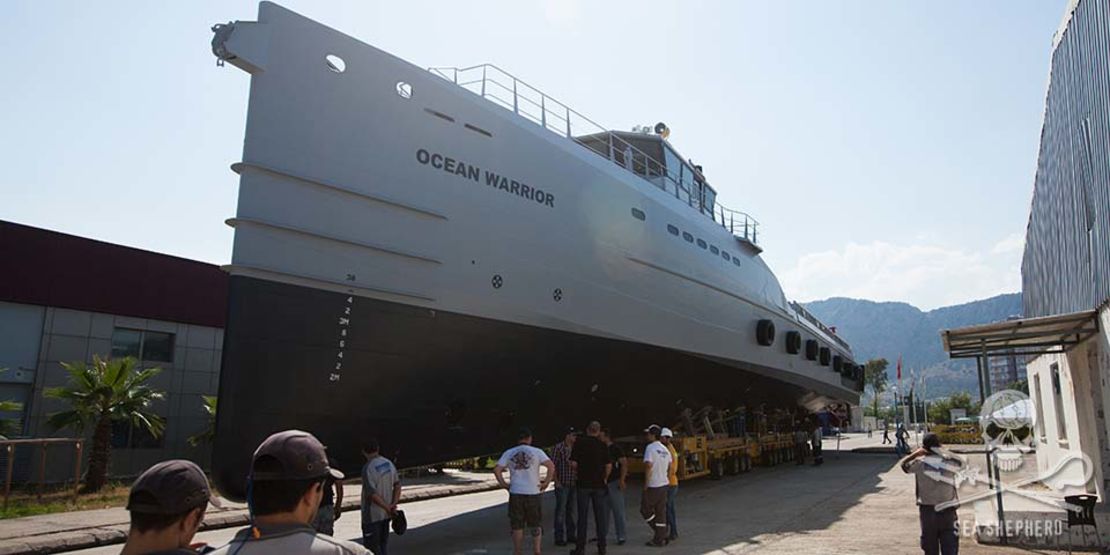Story highlights
Anti-whaling activist group announce the launch of a new ship
The activists group's new campaign in the Southern Ocean comes in the wake of a court loss
Though Japan is often in the media spotlight for its whaling operations, Norway is actually the global leader in whale hunting
Anti-whaling activist group Sea Shepherd announced its 11th whale defense campaign Tuesday with the launch of a custom-built vessel, which it claims will have the requisite muscle to take on Japanese whaling fleets.
“For the first time we will have the speed to catch and outrun the Japanese harpoon ships, knowing speed can be the deciding factor when saving the lives of whales in the Southern Ocean,” Alex Cornelissen, Sea Shepherd Global CEO, said in a statement.

Sea Shepherd told CNN that its new ship – dubbed “Ocean Warrior” – is 54 meters (177 feet) long, displaces 439 tons and can reach speeds of 25 knots and higher. Japanese whaling ships are estimated to reach speeds of up to 22 knots, and Sea Shepherd’s previous ships could only reach 15 knots. A deck area also enables ship operators to dispatch small boat operations and support a helicopter.
The ship was built in Turkey by Dutch shipbuilder Damen from an 8.3 million euro ($9 million) fund awarded to Sea Shepherd by the Dutch, UK and Swedish lotteries.
Ocean Warrior is expected to arrive in Australia at the end of 2016 so it can be prepared for the activist group’s 11th whale defense campaign in the Southern Ocean.
No effect on Australian law
Sea Shepherd’s efforts to strengthen their campaign in the Southern Ocean comes a week after a court-mediated settlement between their US arm and a Japanese whaling institution.
On August 23, a preliminary injunction – which prevents Sea Shepherd’s US branch from disrupting Japanese whaling operations in the Southern Ocean – became permanent, ending a legal dispute that has been raging between the two groups since 2011.
In a statement released on the same day, the Institute of Cetacean Research (ICR), a Japanese nonprofit, said that under the injunction, Sea Shepherd USA would be barred from “physically attacking” their research vessels and crew and from sailing within 500 yards of their whaling ships.
Japan, Australia in ship dispute
Though Sea Shepherd USA confirmed that the organization would comply with the legal restrictions of the injunction, the Australian branch of Sea Shepherd asserted that the injunction over their US arm would not affect conservation operations.
“The US court settlement doesn’t have an affect on Australian law,” Adam Burling, a spokesperson from the Australian-based Sea Shepherd, told CNN.
“This decision does not impact our mission to protect the whales of the Southern Ocean in any way,” he added.
Controversy over Japan’s reasons for whaling
The ICR is a government-backed research institution established in 1987 to study the “biological and social sciences related to whales.”
Their research methods include killing a quota of whales each year to study them. Anti-whaling activists oppose the ICR, claiming the institute is a cover for Japan to kill whales for commercial profit.
In 1982, the International Whaling Commission – an intergovernmental body dedicated to conserving whales – proposed an international moratorium on commercial whaling. The moratorium has been in effect since 1986, however, Japanese fleets still sail to the Antarctic every year in autumn or winter to catch whales. The government asserts the hunts are for scientific purposes and therefore legal.
In 2016, Japan’s whaling fleets killed 333 minke whales. According to the Japanese Ministry of Fisheries, the research was conducted to manage and understand minke whale populations in the Antarctic Ocean.
Anti-whaling organizations, however, insist the hunts are illegal, inhumane and detrimental to whale populations. In 2014, the United Nations’ International Court of Justice ordered Japan to stop its whaling program over concerns of the legitimacy of its scientific activities in the Antarctic region.
Norway, the global leader in whale hunting
Japan is not the only country that engages in whaling.
Since the establishment of the international moratorium, Iceland and Norway have continued to hunt whales commercially. In 2014, Norway caught 746 minke whales and Iceland caught 137 fin whales and 24 minke whales.
According to the International Whaling Commission, these countries establish their own catch limits, but provide all information and scientific data on their catches to the commission.
A report from 2015, co-written by three animal rights NGOs, found that Norway killed more whales each year than some of the most prominent whaling countries combined.
But Japan still continues to receive the most criticism for its whaling missions.
Claire Perry, a ocean campaign leader at the Environmental Investigation Agency said that Japan’s decision to continue whaling under scientific precepts wasn’t the only reason why they garnered more international scrutiny than Iceland or Norway.
“Iceland and Norway whale in northern European waters so it’s seen as a European problem,” Perry told CNN.
She explained that Japan, however, was the only country to whale in international waters of the Southern Ocean, which was declared a sanctuary for whales in 1994. This, she said, made the country a more visible target for NGOs.








